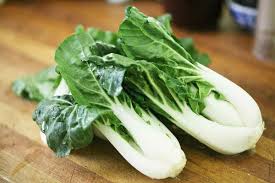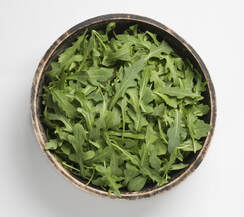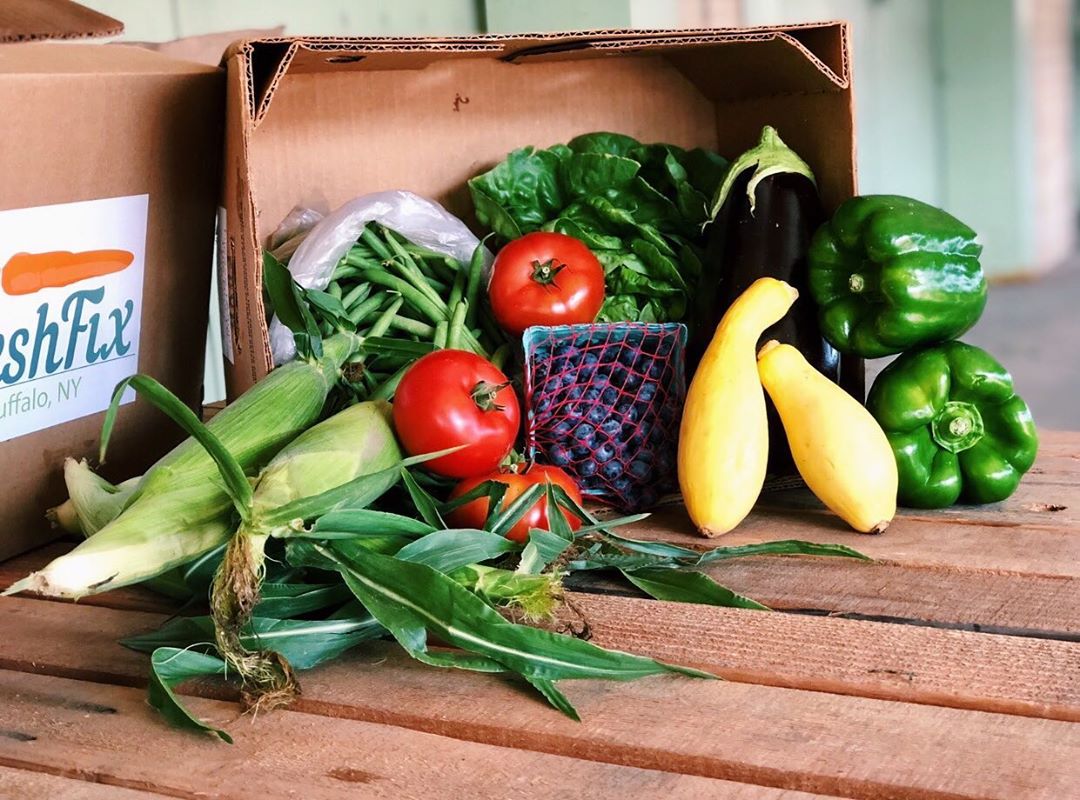 Bok Choy, also called Chinese cabbage and pak-choi, has been grown in China for more than 6,000 years. The greens have a spinach-like taste with a very mild bitterness. You can purchase bok choy in typically two sizes, baby and large mature stalks that’ll need to be chopped into smaller pieces. Although the leaves can be eaten raw and tossed into fresh salads, they are best cooked. Bok Choy is fat free, low in sodiumand calories, an excellent source of vitamin A, vitamin C, and folate. Storage and Preperation Store Bok Choy in a plastic bag in the crisper section of your refrigerator for up to a week. Wait to wash it until you are ready to eat it. To prepare full size baby box choy, remove the bottom of the Bok Choy plant with a sharp knife so that the leaves separate. Rinse each leaf with cool water and pat dry with paper towels or salad spinner. Baby bok choy can be eaten whole or cut into smaller pieces. Start by adding them to a large bowl of cold water and plunge a few times to remove any excess dirt. You can also rinse under running water. If cutting bok choy in half after washing, make sure the inside is dry too, especially if sauteing or stir-frying. Whole baby box choy are great for braises or stews. Recipe IdeasAsparagus and Box Choy Frittata
Great for any brunch, lunch or dinner. Pair with a side salad. Box Choy and Oyster Mushroom Stir-Fry Classic preperation for Box Choy. You can use any mushrooms you like. Braised Bok Choy and Tomatoes This recipes gives a mediterranean flair to a classic asian green. Ginger Garlic Noodle Soup with Bok Choy A great starting point for creating your own noodle soup masterpiece.
0 Comments
 A powerhouse food with great detoxifying benefits, Wild Arugula has a more intense pepper flavor than other types of arugula. It's strong pepper taste makes it a great addition to other dishes including pasta dishes, soups, stews, and sauces. If you want to enjoy it as a salad, it's best when paired with other leafy greens and drizzled with a vinaigrette or when wilted and used in pasta or side dishes. It also makes a great garnish for dishes.
Ways to Enjoy Wild ArugulaArugula can be used in so many ways including fresh, steamed, sauteed, wilted, or even blended. Here are just a few ways you can incorporate it into your cooking.
Wild Arugula RecipesSpicy Arugula & Chicken Soup Recipe from: UpRoot Kitchen
Use the Wild Arugula this week with your onions, tomatoes to make this spicy chicken soup. Add cooked chicken or chicken sausage, top with your leftover pea sprouts and you have a delicious spring soup! Wild Arugula Pesto Recipe from: Grow Forage Cook Ferment For a spicy addition to your Pasta Peddlers pasta, use the wild arugula to create a pesto. Mediterranean Spinach and Arugula Salad Recipe from: YepRecipes Looking for a spring salad? Pair a handful of arugula with fresh spinach, add some bell peppers, red onion and cucumbers, and top with some local goat or feta cheese (found in the web store). #eatlocal has 7,135,332 posts on Instagram! You’ve heard it before, and I’m sure you’ll hear it again and again, especially now as we move forward from a situation that has the potential to change the way many of us eat. The truth is, eating local is more than just a trendy hashtag on social media. Eating local is and always has been a sustainable way to support the businesses and farmers right here in our own community, and a sustainable way to a healthier you. When we eat local, we are shortening the distribution chain, reducing the transportation needed to get the fingerling potatoes to our plates, the arugula to our bowls, and the apples to our crispers (if you like yours cold that is!). Eating local helps our farmers keep the crops growing, and as we embark upon our Spring/Summer seasons in Western New York, we know what amazing vegetables are yet to come. There are many benefits to eating local, but here are a few of our favorites: Local food is fresher and healthier! Fruits and vegetables offer the most nutrients and health benefits when they are eaten at their peak maturity. This means when the squash is picked at the farm, it’s picked close to its peak maturity and delivered to your door within just a few days. To the contrary, squash you find at the grocery store may be imported from a location thousands of miles from here, which means it has a transit time longer than few days. By the time it reaches our table, it’s been more than just a few days since it was picked. Not to mention, much of the produce brought into grocery stores from outside our region has the potential to contain added chemicals and pesticide levels used to help prolong the life of the produce. Thus, eating local allows us to reap the nutritional benefits of what we are eating! It’s good for our environment! By choosing fruits and vegetables grown by local farms, we’re not only helping to maintain our region’s farmlands, but we’re reducing our contribution to the transportation chain that’s chugging fuel. You know where its coming from and where it has been! When you choose to select vegetables grown by our local Western NY farms, you know where the farms are, how the food is grown, and if you don’t, you can ask them! Our local farmers in Western NY are awesome neighbors that are always more than willing to talk to us about how they grow their food. You get to try new foods by eating what’s in season! Before I learned the benefits of eating local, I would buy the same veggies week after week at the grocery store. Rarely would I buy something different, like Romanesco broccoli, patty pan squash, or even a butterhead lettuce. Once I transitioned to supporting our local farmers though, I quickly learned of the amazing variety of fruits and vegetables that we have right here in our own backyard. Also, becoming familiar with the true taste of a fresh fruit or veggie that is in season brings eating local to a whole new level. The taste of something fresh and in season far outweighs anything that travels thousands of miles to get here. So, yes, it’s a trendy term online right now... “eat local”... and it’s being used in many ways. These are our own truths, from FreshFix to the table, about eating local! |
Archives
August 2021
Categories
All
|


 RSS Feed
RSS Feed